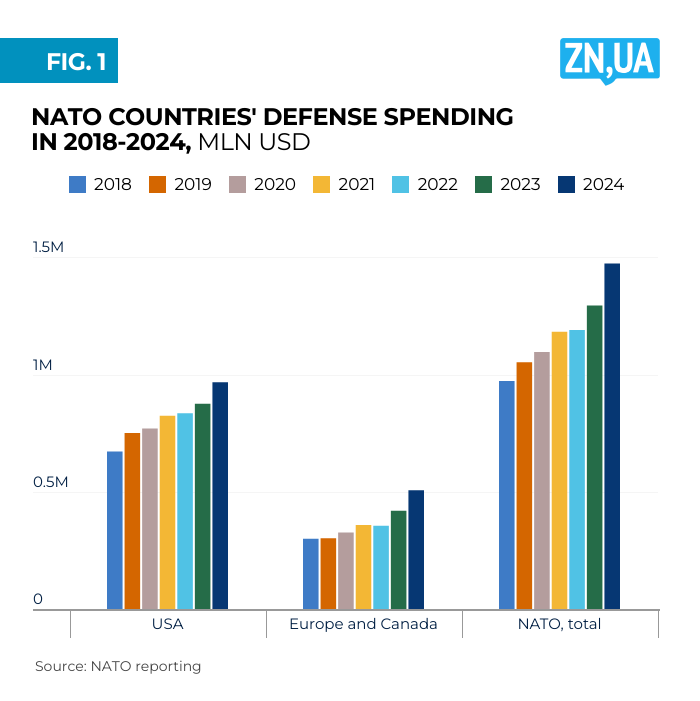5% of GDP on Defense for European Countries: How Realistic Is Donald Trump's Demand?

Five percent of GDP on defense for European NATO members. Is this Donald Trump's trolling or an objective necessity?
The US president-elect is demanding that European NATO member states increase defense spending not to 2%, which is the current standard for these countries, and not even to 3%, which has been increasingly discussed recently, but to 5% of GDP.
Laypeople often say that the problem is not that big. Okay, there was a 2% requirement, and in fact, for many European countries it was much less, now it will be 5% — that is not a big deal. However, in today's objective reality of many European NATO members — the most peaceful, demilitarized and socially-oriented states — this is a huge issue, practically unsolvable in the next decade, unless, of course, they go to war. Then there will be money for everything, but it may be too late.
Once again, it should be noted that we are talking about percentages of gross domestic product (GDP), i.e. the value of all final products, goods, works and services not intended for further processing and resale, produced by residents of a particular country during a year. This is not a percentage of the state budget — the difference is huge.
For example, Ukraine's nominal GDP in 2021 was about UAH 5.5 trillion, while budget revenues amounted to almost UAH 1.3 trillion, or less than 24% of GDP. After the full-scale invasion, these figures rose sharply to more than 34% of GDP in 2022 and almost 41% of GDP in 2023. The same figure can be expected for 2024, as real budget revenues for the year are expected to reach about UAH 3 trillion, and nominal GDP is expected to stand at UAH 8 trillion. However, these figures being extremely high due to extraordinary circumstances in which Ukraine is currently living, they are not typical for most other countries.
In 2024, defense spending in Ukraine from the state budget alone amounted to at least more than 21% of GDP. Taking into account foreign military assistance in the form of weapons, ammunition, equipment, intelligence, training costs for the Ukrainian military, etc., as well as donations from both Ukrainians and foreign donors, the real figure will exceed 30 or even 32% of GDP by a fair margin, as, according to various sources, Ukraine spent up to $64.8 billion on defense in 2024. The draft budget for 2025 envisages spending an unprecedented 26.3% of Ukraine's GDP on defense and security, increasing these costs to UAH 2.23 trillion, half of which will be allocated for salaries for the military, so the real figure could be even higher again.
The Russians will not be surprised by spending 5% of GDP on “defense” today either. Although they are still trying to use the “monkey see, monkey do” approach with the Americans, calling the war they have unleashed a “special military operation,” a kind of pacification of unruly rebels from the periphery to humiliate Ukrainians, the expenditures of their ministry of attack and other organizations and institutions directly or indirectly related to the war and internal security reveal something completely different.
The war budget is growing sharply every year: in 2024, it amounted to 5.4–6.4% of about $2 trillion of Russia's GDP, but in reality, taking into account corruption and a lot of classified budget items that are actually also spent on military needs, and Russia's traditional made-up information about its own GDP and its stable growth, it could be as high as 8–10%. In 2025, even formally, these expenditures could exceed 7% of GDP.
In other words, the modern Russia has surpassed even the Soviet Union at the end of the Cold War in terms of this indicator. For example, in 1989, its defense budget amounted to 77.3 billion rubles out of 494.8 billion rubles of the total budget and 1,606 billion rubles of nominal GDP. Thus, the share of military spending in gross domestic product was 4.8%.
However, for modern civilized countries that are not at war, spending 5% of GDP on defense in the 21st century may seem outright absurdity.
When the US president-elect suggests that Europeans spend 5% on defense, it would be logical to assume that the United States already spends that much and only wants to force its allies to do the same. But this is not the case. Although US defense spending has been growing steadily since at least 2018, it is doing so at roughly the same rate as GDP. The United States spent $782 billion on defense out of $2,357 billion of GDP in 2023 and $842 billion out of $2,781 billion of GDP in 2024 (forecast data). This is only 2.86 and 2.93% of GDP, respectively. NATO reports provide slightly different data on the defense spending of its most valuable member: $875.6 and $967.7 billion in 2023 and 2024, i.e. 3.2% and 3.36% of GDP, which is still quite far from 5%. Of course, the Americans can always rightly point out that the war is on the European continent, not across the Atlantic, but this claim still does not seem entirely fair.
Germany, which in 2023 spent only €67.6 billion (about $73.17 billion) on defense out of $4,457 billion of GDP, which was 1.64%, and thus did not meet the NATO standard of 2% even in the second year of a full-scale war in Europe, sharply increased these expenditures to €90.6 billion ($98.1 billion) in 2024, i.e. to 2.14% of the expected GDP of $4,591 billion.
However, in order to meet Donald Trump's 5% target, Germany would hypothetically have to spend $229.5 billion on defense, slightly more than China, whose GDP is four times that of Germany. This is about 15% more than the entire GDP of Ukraine in 2024. In other words, Berlin would have to find an additional $130 billion somewhere. There are few options: either to sharply raise taxes, which in Germany and many other EU countries are already so high that they significantly affect the investment climate and the living standards of many citizens, or to sharply cut other budget expenditures, primarily social and infrastructure.
The situation is similar with the United States itself, except that Germany would have to look for $470–600 billion instead of 130. Could the leadership of these countries, under the current conditions, when the war seems to most of their citizens, as it did to us, to be a scare story rather than a real prospect for the coming years, explain such huge expenditures to their voters? The question is obviously rhetorical.
Does NATO have even a vague chance of reaching defense spending of 5% of GDP in the coming years? In general, obviously not, but some countries may try to meet this promising standard. Let's look at the infographic based on NATO’s own reports (see Figures 1–3).
The first thing that strikes the eye is the fact that in 2024, US defense spending will still account for almost two-thirds (65.6%) of the total spending of all NATO countries, despite the fact that nominal spending by other members has been growing faster recently. However, back in 2018, it was 69.1% of total spending. The US GDP is also larger than the GDP of all other members combined, although NATO includes five other countries in the top ten by this indicator, the difference is less than one and a half times, while in terms of defense spending it is almost two times. So, the United States does spend more on defense than its allies, and it has the right to criticize them.
While in 2018–2019 not all NATO members spent even 1% of GDP on defense, in 2024, the vast majority of them already provided at least 2%, with the best dynamics observed over the past three years, especially in those countries that are Russia's neighbors. The worst performers are Belgium, Canada, Italy, Luxembourg, Portugal, Slovenia and Spain, which, by a “strange” coincidence, do not share borders with Russia, although all of them, except Canada, have demonstrated an upward trend.
In addition to the United States, the leaders in terms of spending as a percentage of GDP include Poland, Estonia, Latvia, Lithuania and Greece. And while the latter's spending peaked in 2021–2022 and is more likely to be related to the conflict with Turkiye than to Russia's war against Ukraine, the other four countries are obvious “candidates” for further Russian aggression. They are well aware of this, and they are the only ones who have a chance to fulfill “Trump's norm” in the coming years. Unfortunately, our great friends, the Baltic states, are, for objective reasons, among the smallest economies in NATO and are physically unable to resist potential aggression without the help of their allies. However, we can be quite sure of their courage and unwillingness to be under Russian occupation again, which is not the case with many other NATO members. So, the only one of Russia's neighbors who really takes the threat seriously and is potentially capable of putting up a decent fight is Poland.
The rest of the NATO countries, including even the United States itself, have little chance of reaching the 5% of GDP defense spending figure in the next decade, unless something truly terrible happens. Importantly, the continuation of the war in Ukraine is not such a horror for them. The obvious “black swan” here would be an attack on a NATO member, which everyone hopes will not happen because Russia is weakened by the war against Ukraine. To a lesser extent, a new war in Korea or an attempted annexation of Taiwan could serve as incentives to spend more on defense.
The world of today is changing rapidly, and unfortunately, in most cases, not for the better. Almost all Ukrainians today would gladly agree to pay 5% of their GDP for the next hundred years, if only to avoid what has already happened. If only our people would not die or be maimed, if only our homes, businesses and infrastructure would not be destroyed, if only millions of people would not remain under occupation and flee the country forever, and if only they would not have to be replaced by the very migrants who are now causing a fever in all of Europe. Russia is also taking advantage of this, artificially boosting the popularity of right-wing and left-wing parties that advocate for restricting migration.
In fact, the US president-elect's proposal to spend 5% of GDP on defense has a lot of rationality to it. Perhaps even more than he can realize. After all, today the initiative for European countries, which until a few years ago often did not spend even 1% of GDP on defense, looks more like trolling, which can also be expected from Donald Trump.
However, if what is called Western civilization, which we now believe to be part of, seeks to survive and preserve its values in the fight against autocracies and dictatorships, it will have to change and, in some aspects, repeat the path of Ukraine, which it did not choose to take. Will the citizens and leaders of Western countries be able to understand this and will they be able to do so in time?
Please select it with the mouse and press Ctrl+Enter or Submit a bug














 Login with Google
Login with Google